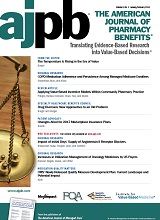Publication
Article
AJPB® Translating Evidence-Based Research Into Value-Based Decisions®
CMS' Newly Released Quality Measure Development Plan: Current Landscape and Potential Impact
Author(s):
Pursuant to the Medicare Access & CHIP Reauthorization Act, CMS has released a draft Measure Development Plan detailing steps the federal government will take to incorporate measuring and reporting of quality measurements.
SUMMARY ABSTRACT
Pursuant to the Medicare Access & CHIP Reauthorization Act (MACRA), CMS recently published its draft Measure Development Plan and proposes a plan for incorporating quality performance measures into the Merit-Based Incentive Payment System and alternative payment models (APMs). In addition, the Measure Development Plan aligns and harmonizes existing, as well as future, performance measures by standardizing measure-development efforts within Medicare. CMS also provides responses to legislative queries, which aim to clarify CMS’ plans for implementation. Ultimately, the Measure Development Plan will play a major role in paving the way to a value-based payment model within Medicare—Secretary Burwell’s goal of having at least 50% of Medicare payments being made under an APM.
Am J Pharm Benefits. 2016;8(1):e14-e16
Let’s start our discussion with a short quiz. Do you recognize the following acronyms: MIPS, APM, MACRA, PQRS, and VM? Can you explain the interrelationship of the terms alignment, harmonization, and measurement burden? How does the CMS Measure Development Plan tie all these acronyms and terms together? If you had some difficulty with these questions, don’t worry as this article will provide an overview of the CMS Measure Development Plan.1
In a nutshell: under HHS Secretary Burwell’s initiative, the federal government is incentivizing Medicare providers to engage in quality measurement and to report their results, thereby moving toward quality-based payments.2 CMS has developed several quality-based—also referred to as value-based, merit-based, or incentive-based—payment structures within Medicare for eligible providers (EPs) (healthcare providers that are eligible or required to participate in these programs). Currently, 3 programs stand apart from the rest: the Physician Quality Reporting System (PQRS), Value Modifier (VM), and the Electronic Health Record Incentive Program (also referred to as “Meaningful Use” [MU]) (see Table 1 for an overview).3-5
However, 2 concerns can be raised for each program. First, the quality measures used in these programs are not aligned and harmonized with each other. Also, the plethora of measures used across 20 federal programs have been criticized as a key factor leading to the problem of “measurement burden”—the additional burden of implementing, tracking, and monitoring quality measures—for providers.
Through the most recent and impactful legislation addressing quality, the Medicare Access and CHIP Reauthorization Act (MACRA) of 2015, Congress tasked HHS to directly address the concerns mentioned above. As a requirement of this Act, CMS subsequently developed the CMS Quality Measure Development Plan (MDP) draft, which was posted for comment on December 18, 2015.
The plan essentially proposes a strategy and pathway to implement the Merit-Based Incentive Payment System (MIPS) and alternative payment models (APMs)6 (See Table 2). Additionally, this plan also supports HHS Secretary Burwell’s 3-year initiative to move away from fee-for-service payments and have at least 50% of Medicare payments based on APMs by 2018.2
Now let’s take some time to understand what we have so far. First, what does “alignment and harmonization” of measures across programs mean? Alignment and harmonization refers to the use of common or similar measures across programs nationwide; the lack of alignment is a critical barrier to effectively measure quality.
A study conducted by Bailit Health in 2013,7 found that programs nationwide have “very few measures in common,” as only 7.5% of 1367 measures are used by more than one program. It should be noted, however, that of the 1367 measures identified, only 509 were distinct from each other, and only 102 measures were used by more than one program.
Furthermore, this lack of alignment can be seen in each of the 3 aforementioned quality-based CMS payment programs: PQRS, VM, and MU. Each program relies on the use and reporting of quality measures by EPs to determine if a payment adjustment is warranted and, if so, by how much.
Currently, most quality measures in each program have been developed independently of one another, which results in little alignment. Ultimately, if the lack of alignment persists, providers will likely face heavy measurement burden on top of already existing regulations and requirements, and this is further complicated by payers increasingly using different measures, different variations of a measure, and even different combinations of common measures. A provider will likely be forced to choose between quality-based payment programs due to limited resources; however, alternatively, the provider may not even have a choice when participating in some programs. For example, unless an exception applies, all EPs eventually must enroll in MIPS or an APM in order to participate in Medicare.
Harmonization can be found in the way MIPS and APMs will be implemented pursuant to MACRA. CMS is required to incorporate PQRS, VM, and MU into MIPS, resulting in the use of a single set of quality measures. Also, EPs who choose to enroll in an APM instead of MIPS will also be using quality measures that are the same as, or largely similar to, those used in MIPS. This alignment of quality measures used by EPs across Medicare is likely to result in a more streamlined process, and is also likely to lower measurement burden within Medicare.
As you may be able to tell by now, there are numerous requirements within MACRA for the MDP. One such provision required the HHS Secretary to have developed and posted “a draft plan for the development of quality measures” by January 1, 2016.8 In compliance, CMS posted the draft CMS Quality Measure Development Plan (MDP) for comments, which will “serve as a strategic framework for the future of clinician quality measure development to support MIPS and APMs.”1
Specifically, the draft MDP seeks to accomplish several goals: first, CMS provides a pathway for incorporating PQRS, VM, and MU into MIPS. Second, CMS proposes a plan to identify and repurpose existing quality measures and other quality-related resources to create common measures to be used in MIPS. Third, the plan proposes a set of new standards for future measure development that will help to align quality measures.
CMS also lists several challenges—engaging patients into the measure development process, reducing provider burden, shorter measure development processes, producing meaningful measures that are aligned across federal programs, developing PROMs (patient reported outcome measures), and ensuring accountability across settings and providers—as well as a strategic plan to prevent or alleviate these challenges. Additionally, CMS provides responses to requirements within MACRA that must be addressed in the MDP (see Table 3 for a list of the MDP requirements).1,8
Two notable requirements are the gap analysis and establishing of quality domains and priorities. The gap analysis and prioritization will provide a comprehensive landscape of quality measures, identify areas of need, and then prioritize the measures by need. The quality domains are a set of goals and principles that CMS will follow to identify opportunities to collaborate with stakeholders to ensure that measures matter to patients, caregivers, and providers.
So, why should we care about the MDP? Ultimately, the MDP will function as a strategic plan to achieving HHS Secretary Burwell’s initiative of moving away from fee-for-service payments. The MDP supports this initiative by setting out clear goals and a straightforward pathway toward proper alignment of quality measures during MIPS implementation. The plan also prudently proposes to rely on existing resources instead of attempting to reinvent the wheel. Once the MDP is finalized, Secretary Burwell’s goal of having at least 50% of Medicare payments made under an APM will become that much more attainable.
Author Affiliation: Pharmacy Quality Alliance, Washington, DC.
Funding Source: None
Author Disclosures: None
Authorship Information: Concept and design; acquisition of data; analysis and interpretation of data; drafting of the manuscript; critical revision of the manuscript for important intellectual content.
Send correspondence to: Daniel J. Nam, RPh, Esq, Pharmacy Quality Alliance, 6213 Old Keene Mill Ct, Springfield, VA 22152. E-mail: dnam@pqaalliance.org.
REFERENCES
1. CMS quality measure development plan: supporting the transition to the merit-based incentive payment system (MIPS) and alternative payment models (APMs) (draft). CMS website. https://www.cms.gov/Medicare/Quality-Initiatives-Patient-Assessment-Instruments/Value-Based-Programs/MACRA-MIPS-and-APMs/Draft-CMS-Quality-Measure-Development-Plan-MDP.pdf. Published December 18, 2015. Accessed February 5, 2016.
2. Better, smarter, healthier: in historic announcement, HHS sets clear goals and timeline for shifting Medicare reimbursements from volume to value. HHS website. http://www.hhs.gov/about/news/2015/01/26/better-smarter-healthier-in-historic-announcement-hhs-sets-clear-goals-and-timeline-for-shifting-medicare-reimbursements-from-volume-to-value.html. Published January 26, 2015. Accessed February 5, 2016.
3. Physician Quality Reporting System. CMS website. https://www.cms.gov/Medicare/Quality-Initiatives-Patient-Assessment-Instruments/PQRS/index.html?redirect=/pqri/. Published December 23, 2015. Accessed February 5, 2016.
4. Value-Based Payment Modifier. CMS Website. https://www.cms.gov/medicare/medicare-fee-for-service-payment/physicianfeedbackprogram/valuebasedpaymentmodifier.html. Accessed February 5, 2016.
5. Electronic Health Records (EHR) Incentive Programs. CMS website. https://www.cms.gov/Regulations-and-Guidance/Legislation/EHRIncentivePrograms/index.html?redirect=/ehrincentiveprograms. Updated January 26, 2016. Accessed February 5, 2016.
6. The Merit-Based Incentive Payment System (MIPS) & alternative payment models (APMs): delivery system reform, Medicare payment reform, & the MACRA. CMS website. https://www.cms.gov/Medicare/Quality-Initiatives-Patient-Assessment-Instruments/Value-Based-Programs/MACRA-MIPS-and-APMs/MACRA-MIPS-and-APMs.html. Accessed February 5, 2016.
7. Reinhalter Bazinsky K, Bailit M. The significant lack of alignment across state and regional health measure sets: an analysis of 48 state and regional measure sets, presentation. Bailit Health website. http://www.bailit-health.com/articles/091113_bhp_lackofalignment.pdf. Published September 10, 2013. Accessed February 5, 2016.
8. Medicare Access and CHIP Reauthorization Act of 2015 (MACRA). 114th Congress (2015-2016). Congress.gov website. https://www.congress.gov/bill/114th-congress/house-bill/2?q=%7B%22search%22%3A%5B%22medicaid+access+and+chip+reauthorization+act%22%5D%7D&resultIndex=1. Accessed February 5, 2016.

Newsletter
Stay informed on drug updates, treatment guidelines, and pharmacy practice trends—subscribe to Pharmacy Times for weekly clinical insights.






